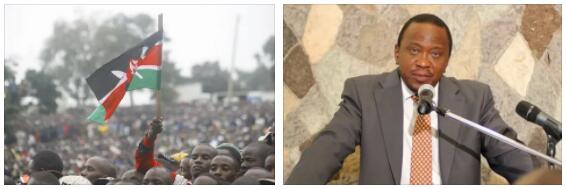State structure and political system of Kenya
Kenya is a republic. The Constitution adopted on December 12, 1963 (as amended in 1964, 1969, 1979, 1983, 1986, 1988, 1991, 1992, 1997, 2001) is in force. The head of state is the president, who is elected by direct universal suffrage for a term of 5 years and can be re-elected for another term. Legislative power is exercised by the president and a unicameral parliament – the National Assembly (224 deputies, of which 210 are elected by direct universal suffrage for 5 years and 12 are appointed by the president). Parliament consists of the Speaker and the Attorney General. Executive power is exercised by the president, as well as by the vice president and the government, whom the president appoints from among the deputies of the National Assembly (elected in December 2002, speaker – F. ole Caparo). Check cancermatters for political system of Kenya.
In December 1991, a law was passed introducing a multi-party system in the country. In total, approx. 20 parties. The main political force in the country is the Rainbow National Coalition. It was formed on the eve of the 2002 elections and unites 15 political parties, incl. Democratic Party, has 125 seats in the National Assembly. The second party in terms of representation in parliament is KANU (64 seats). In March 2002, it merged with the National Development Party (founded in 1994), retaining the name KANU.
The trade union movement in the country is headed by the Central Organization of Trade Unions of Kenya, established in 1965 and numbering more than 600,000 members.
Administrative division – 7 provinces and the capital district. Large cities (thousand people): Nairobi, Mombasa (707), Kisumu (273), Nakuru (337), Eldoret (249), Nyeri (213), Meru (141), Tika (89).
The armed forces of Kenya number 24.2 thousand people, including the Ground Forces (20.5 thousand), the Air Force – 2.5 thousand, the Navy – 1.2 thousand. 5 thousand people serve in the police.
Kenya has diplomatic relations with the Russian Federation (established with the USSR on December 14, 1963).
Economy of Kenya
GDP $11.4 billion, or $350 per capita (2001). The average annual GDP growth in 2000-01 was 0.5%. GDP structure: agriculture 24%, industry 13%, services 63%. The economically active population is 10 million people, 75-80% are employed in agriculture (2001). Inflation 3.3% (2001).
Kenya is an agrarian country with a relatively developed agriculture. The main marketable products (average annual harvest in 2000–02): tea (220,000 tons), coffee (80,000 tons), sugar cane (4,650,000 tons), wheat, corn, sisal, pyrethrum, and cotton are produced on large farms. (3.2 thousand) and small peasant farms (1.2 million). The production of coffee, tea, sisal is oriented towards export (Kenya ranks 2nd in the world in terms of production). For domestic consumption, cassava, sweet potato, grains are grown – wheat (350 thousand tons), rice (55 thousand tons), corn (2800 thousand tons), millet, sorghum, potatoes, bananas. Animal husbandry is represented by cattle breeding (14 million heads), sheep and goats (13 million), camels (810 thousand), pigs (104 thousand). Catch of fish and seafood 180 thousand tons.
The industry is represented by the mining industry (extraction of natural soda – 124 thousand tons, fluorite – 31 thousand tons, table salt – 74 thousand tons, gold, rubies), enterprises for processing agricultural raw materials, meat and dairy industry, chemical, building materials, textile, oil refining, woodworking. Electricity production – 4.6 billion kWh (2000).
Tourism is one of the most developed and promising sectors of the economy. In different years, from 400 to 800 thousand foreign tourists visited the country. Income from tourism has become an important item of the country’s foreign exchange earnings.
The length of railways is 2,778 km, roads – 63,800 km, incl. 8932 km paved. Oil pipeline 483 km. Major ports: Kisumu, Lamu, Mombasa. There are 231 airports, incl. 20 modern class.
The ongoing economic policy is aimed at liberalizing and reforming the national economy with the participation of experts from the IMF and the World Bank. Particular attention is paid to anti-corruption activities at all levels.
Budget (2000): revenues $2.91 billion, expenditures $2.97 billion.
External debt of 4.4 billion US dollars, deductions on account of its repayment of 15.4% of the country’s export earnings (2001).
Foreign trade turnover 5.6 billion US dollars: export 1.9 billion dollars (tea, flowers, coffee, oil products, fish, cement); imports $3.7 billion (machinery, equipment and vehicles, petroleum products, iron and steel, resins and plastics) (2001). Main trading partners: for export – Uganda, Tanzania, Great Britain, Germany, the Netherlands, Ethiopia, Rwanda, Egypt, JRA, USA; imports – Great Britain, Japan, South Africa, United Arab Emirates, Italy, India, France, USA, Saudi Arabia.
50% of the country’s population lives below the poverty line.
Science and culture of Kenya
In Kenya, universal primary education has been introduced, since 1980 it has been free. There are 15 thousand primary schools, 2.5 thousand secondary schools. School education covers approx. 70% of children of the appropriate age. The state system of higher education is represented by the University of Nairobi, the University. J.Kenyatta, University. D. Moi, Egerton University, Agricultural and Technical Colleges. There are also 13 private universities.
